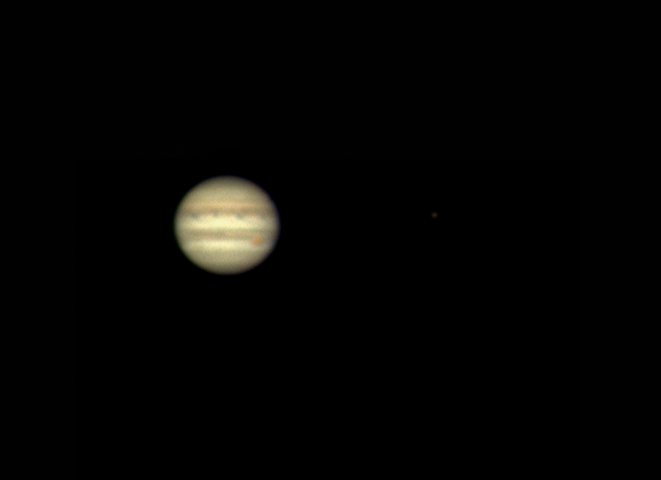In my latest observing session, I had setup my C-11 on the Losmandy mount, and it was a nice, clear brisk night. A little transparency and seeing issues but that just pushed me to check out some deep space objects. However, on this night, I had no plan in mind, and had to “get creative“ on the fly.

I really wanted to observe some far off galaxy to get my imagination into things. I guess I wanted to look at some very distant land, thinking that maybe someone or something was observing me right back. Seeing nothing but a fuzzy object with little definition and a bit of structure, my mind drifted to the orientation at which they would be observing the Milky Way Galaxy. The three dimensionality of space and our orientation in the Milky Way has always intrigued me. I long for a three dimensional model of the universe to ask such questions of.
I had never looked at NGC 7331 visually, just observations from the armchair admiring other’s photographic efforts. Hey Pegasus was up in the sky, so why not observe what many people refer to as the Milky Way’s Twin. Looking at TheSkyX, I noticed that there are other more faint galaxies in the that region of space. Maybe I would get lucky, and see some of these more faint galaxies as well. So be it, syncing the Losmandy to the stars Sheat and Matar in Pegasus, I then punched in NGC 7331. The scope did its job, and there was a faint fuzzy in my 55 mm EP.
I centered the object up, and then placed the always trustworthy 17mm Nagler into the diagonal. Again, re-centered, and this was likely the best of my eye pieces for this job. It was time to let the staring begin. I stared directly at it for about 5 minutes before testing averted vision views. With direct vision, I was able to see enough structure to know that it was not edge on, and that it was near edge on. As my eye adjusted, the object grew slightly in size, but no where near what I wanted it to grow to. Then it was time to throw my jacket over my head to block any errant street lights from polluting my view.

I started to use more averted vision on the object and started to pan and scan the best spot to set my eye. I started to see a few other fuzzies in there as well. As I scanned around, it became obvious to me that there was some form of a dark lane following what looked like the front portion of the spiral. Looking at photos now, I believe this is where the central bulge appears to have a slightly different plane to it than the spiral arms. The other fuzzies I saw I am guessing were the larger of the background spiral galaxies that are face on. On those I could not make out much more clarity. However, the view was breathtaking. Nothing like getting even a little clarity on a distant galaxy – about 50 million light years away!
When observing objects of this type, I often chuckle at the fact that I know there is much more detail there than what can normally be seen with the naked eye. It makes me reflect upon what astronomers prior to astro-photography might have thought about what they were seeing in the “spiral nebula” of the time. Did they believe there was more detail to be seen there, and what was whipping through their minds with the absence of Google images?
Now NGC 7331 is often touted as being a close analog to our Mily Way Galaxy. However, there is one key difference between the two. NGC 7331’s central bulge is spinning in a retrograde motion. Looking at the central bulge, it appears to be at a slightly different plane than the rest of the galaxy’s spiral arms. Some believe this to be an effect of the retrograde motion. This behavior has not yet been explained, at least from what my research has shown.
Object Name: NGC 7331
Object Type: Spiral Galaxy
RA (current): 22h 37m 32.540s
Dec (current): +34° 28′ 34.425″
RA (2000.0): 22h 37m 05.102s
Dec (2000.0): +34° 25′ 12.998″
Major Axis: 10.2
Minor Axis: 4.2
Axis Position Angle: 170° 00′
Magnitude: 9.50
Blue mag: 10.3
Surface brightness: 13.4
Constellation: Pegasus
Constellation (Abbrev.): Peg
Catalog Number: 7331
Celestial Type: 8
Spiral Arm Span: 100,000 ly
Distance: 50 million ly
The list of Milky Way similarities is extensive, including about the same spiral arm span of 100,000 light years, a black hole at the central core about the same size as our own, and believed to have very similar spiral arms structures. If the similarities are accurate, then it is also possible that the Milky Way Galaxy may also contain a region active in star formation about 20,000 light years from the core as observed in NGC 7331. However, we are unable to see this region in our own galaxy if it exists.

Reference and Sources:
Wikipedia – http://en.wikipedia.org/wiki/NGC_7331
APOD (10/24/2009) – http://antwrp.gsfc.nasa.gov/apod/ap091024.html
APOD (7/1/2009) – http://antwrp.gsfc.nasa.gov/apod/ap040701.html
Spitzer Space Telescope – http://www.spitzer.caltech.edu/Media/releases/ssc2004-12/ssc2004-12a.shtml

